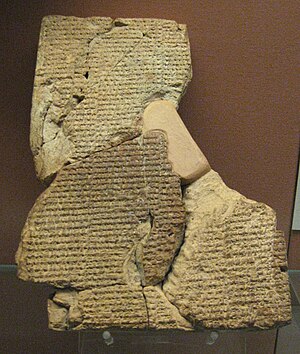Atra-Hasis

Published on: February 13, 2025
A Scholarly Comparison of the Atra-Hasis and the Genesis Creation Account
Introduction
The Atra-Hasis is an ancient Mesopotamian myth that provides one of the earliest known flood narratives and creation accounts, dating back to the 18th century BCE. The Genesis Creation Account, found in the first two chapters of the Bible, presents the Judeo-Christian account of creation and the early history of humanity. Both texts share thematic similarities, particularly in their descriptions of divine creation, human purpose, and divine judgment, leading scholars to compare their theological and literary elements.
From a Christian perspective, the Genesis account is divinely inspired Scripture, while Atra-Hasis represents a human attempt to explain origins through mythology. This article explores the key similarities and differences between the two accounts, examining their theological implications and the Christian interpretation of these texts.
Comparative Analysis
The following table outlines the key similarities and differences between Atra-Hasis and Genesis:
| Aspect | Atra-Hasis | Genesis | Christian Perspective |
|---|---|---|---|
| Creation of Humanity | Humans created from clay mixed with the blood of a slain god to relieve the gods of labor (Dalley, 1989, p. 9). | God forms man from the dust of the ground and breathes life into him (Genesis 2:7). | Genesis portrays creation as an intentional and personal act of a loving God, while Atra-Hasis depicts human creation as a response to divine labor concerns. |
| The Role of Divine Judgment | The gods send a flood to control human overpopulation and noise, nearly exterminating mankind (Dalley, 1989, p. 24). | God sends a flood due to humanity’s increasing wickedness (Genesis 6:5-7). | The Genesis flood emphasizes God's justice and mercy through Noah's salvation, in contrast to the arbitrary nature of divine judgment in Atra-Hasis. |
| Survivor of the Flood | The god Enki warns Atra-Hasis to build a boat and preserve life (Dalley, 1989, p. 27). | Noah finds favor with God, who instructs him to build an ark (Genesis 6:13-22). | Noah is chosen because of his righteousness, aligning with the biblical theme of covenantal faithfulness rather than mere favoritism. |
| The Nature of the Divine | The gods are capricious, bound by limitations, and engage in conflicts (Dalley, 1989, p. 8). | God is sovereign, omnipotent, and acts with purpose and moral clarity (Genesis 1:1, 6:5-8). | The monotheistic portrayal of God in Genesis affirms divine consistency, unlike the polytheistic inconsistencies in Atra-Hasis. |
| Purpose of Humanity | Humans exist to serve the gods and reduce their labor (Dalley, 1989, p. 9). | Humans are created in God's image to steward creation and enjoy fellowship with Him (Genesis 1:26-28). | Genesis elevates human dignity, emphasizing a relational and covenantal purpose rather than servitude. |
| Flood and Covenant | Ends with a compromise among the gods to manage human population (Dalley, 1989, p. 30). | Ends with a divine covenant, symbolized by the rainbow, affirming God's faithfulness (Genesis 9:8-17). | The Noahic Covenant foreshadows God’s plan of redemption, culminating in Christ’s ultimate salvation. |
Conclusion
While both Atra-Hasis and Genesis contain parallels in structure and themes, the theological differences are profound. A Christian perspective views Genesis as the inspired Word of God, offering a coherent and moral vision of creation and divine justice, while Atra-Hasis reflects ancient human attempts to understand existence. The Genesis account provides a foundation for Christian theology, emphasizing God's sovereignty, moral authority, and redemptive plan for humanity.
For Christians, Atra-Hasis is an important find because it highlights the historical and cultural context in which biblical narratives were recorded. The similarities between the two accounts affirm the antiquity of biblical themes, while the differences reinforce the unique theological truths of Scripture. The Genesis account’s emphasis on a personal, moral, and covenantal God serves as a contrast to the polytheistic and transactional deities in Mesopotamian mythology, further strengthening the Christian understanding of divine revelation and salvation history.
References
Dalley, S. (1989). Myths from Mesopotamia: Creation, The Flood, Gilgamesh, and Others. Oxford University Press. The Holy Bible, New International Version (NIV).